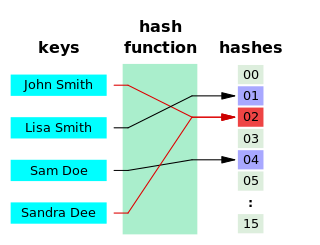In cryptography, a block cipher is a deterministic algorithm that operates on fixed-length groups of bits, called blocks. Block ciphers are the elementary building blocks of many cryptographic protocols. They are ubiquitous in the storage and exchange of data, where such data is secured and authenticated via encryption.

A hash function is any function that can be used to map data of arbitrary size to fixed-size values, though there are some hash functions that support variable length output. The values returned by a hash function are called hash values, hash codes, hash digests, digests, or simply hashes. The values are usually used to index a fixed-size table called a hash table. Use of a hash function to index a hash table is called hashing or scatter storage addressing.

In computing, a hash table, also known as a hash map or a hash set, is a data structure that implements an associative array, also called a dictionary, which is an abstract data type that maps keys to values. A hash table uses a hash function to compute an index, also called a hash code, into an array of buckets or slots, from which the desired value can be found. During lookup, the key is hashed and the resulting hash indicates where the corresponding value is stored.

In cryptography, an HMAC is a specific type of message authentication code (MAC) involving a cryptographic hash function and a secret cryptographic key. As with any MAC, it may be used to simultaneously verify both the data integrity and authenticity of a message. An HMAC is a type of keyed hash function that can also be used in a key derivation scheme or a key stretching scheme.

A cryptographic hash function (CHF) is a hash algorithm that has special properties desirable for a cryptographic application:
In cryptography, the Elliptic Curve Digital Signature Algorithm (ECDSA) offers a variant of the Digital Signature Algorithm (DSA) which uses elliptic-curve cryptography.
S/KEY is a one-time password system developed for authentication to Unix-like operating systems, especially from dumb terminals or untrusted public computers on which one does not want to type a long-term password. A user's real password is combined in an offline device with a short set of characters and a decrementing counter to form a single-use password. Because each password is only used once, they are useless to password sniffers.

A one-time password (OTP), also known as a one-time PIN, one-time authorization code (OTAC) or dynamic password, is a password that is valid for only one login session or transaction, on a computer system or other digital device. OTPs avoid several shortcomings that are associated with traditional (static) password-based authentication; a number of implementations also incorporate two-factor authentication by ensuring that the one-time password requires access to something a person has as well as something a person knows.
In cryptography, Optimal Asymmetric Encryption Padding (OAEP) is a padding scheme often used together with RSA encryption. OAEP was introduced by Bellare and Rogaway, and subsequently standardized in PKCS#1 v2 and RFC 2437.
A rainbow table is a precomputed table for caching the outputs of a cryptographic hash function, usually for cracking password hashes. Passwords are typically stored not in plain text form, but as hash values. If such a database of hashed passwords falls into the hands of an attacker, they can use a precomputed rainbow table to recover the plaintext passwords. A common defense against this attack is to compute the hashes using a key derivation function that adds a "salt" to each password before hashing it, with different passwords receiving different salts, which are stored in plain text along with the hash.
In cryptography, a Lamport signature or Lamport one-time signature scheme is a method for constructing a digital signature. Lamport signatures can be built from any cryptographically secure one-way function; usually a cryptographic hash function is used.
In cryptography, a pseudorandom function family, abbreviated PRF, is a collection of efficiently-computable functions which emulate a random oracle in the following way: no efficient algorithm can distinguish between a function chosen randomly from the PRF family and a random oracle. Pseudorandom functions are vital tools in the construction of cryptographic primitives, especially secure encryption schemes.
In mathematics and computing, universal hashing refers to selecting a hash function at random from a family of hash functions with a certain mathematical property. This guarantees a low number of collisions in expectation, even if the data is chosen by an adversary. Many universal families are known, and their evaluation is often very efficient. Universal hashing has numerous uses in computer science, for example in implementations of hash tables, randomized algorithms, and cryptography.

In cryptography, the Merkle–Damgård construction or Merkle–Damgård hash function is a method of building collision-resistant cryptographic hash functions from collision-resistant one-way compression functions. This construction was used in the design of many popular hash algorithms such as MD5, SHA-1 and SHA-2.
In cryptography, Galois/Counter Mode (GCM) is a mode of operation for symmetric-key cryptographic block ciphers which is widely adopted for its performance. GCM throughput rates for state-of-the-art, high-speed communication channels can be achieved with inexpensive hardware resources.
Post-quantum cryptography (PQC), sometimes referred to as quantum-proof, quantum-safe, or quantum-resistant, is the development of cryptographic algorithms that are thought to be secure against a cryptanalytic attack by a quantum computer. The problem with popular algorithms currently used in the market is that their security relies on one of three hard mathematical problems: the integer factorization problem, the discrete logarithm problem or the elliptic-curve discrete logarithm problem. All of these problems could be easily solved on a sufficiently powerful quantum computer running Shor's algorithm or even faster and less demanding alternatives.
Network coding has been shown to optimally use bandwidth in a network, maximizing information flow but the scheme is very inherently vulnerable to pollution attacks by malicious nodes in the network. A node injecting garbage can quickly affect many receivers. The pollution of network packets spreads quickly since the output of honest node is corrupted if at least one of the incoming packets is corrupted.
Fuzzy extractors are a method that allows biometric data to be used as inputs to standard cryptographic techniques, to enhance computer security. "Fuzzy", in this context, refers to the fact that the fixed values required for cryptography will be extracted from values close to but not identical to the original key, without compromising the security required. One application is to encrypt and authenticate users records, using the biometric inputs of the user as a key.
In cryptography, server-based signatures are digital signatures in which a publicly available server participates in the signature creation process. This is in contrast to conventional digital signatures that are based on public-key cryptography and public-key infrastructure. With that, they assume that signers use their personal trusted computing bases for generating signatures without any communication with servers.
Hash-based cryptography is the generic term for constructions of cryptographic primitives based on the security of hash functions. It is of interest as a type of post-quantum cryptography.




















